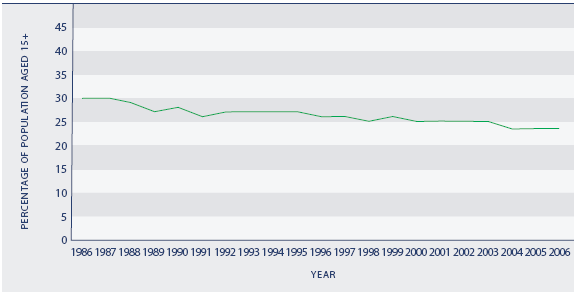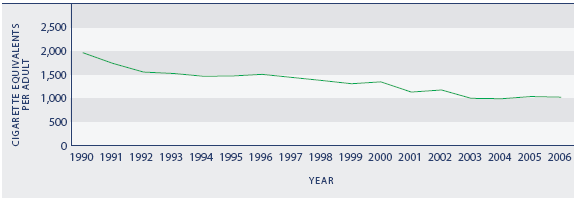Cigarette smoking
Definition
The proportion of the adult population who currently smoke cigarettes.
Up to 2005, the survey population was people aged 15 years and over
(ACNielsen survey). From 2006, the survey population is people aged
15-64 years (New Zealand Tobacco Use Survey).
Relevance
Tobacco smoking is a well-recognised risk factor for many
cancers and for respiratory and cardiovascular diseases. In addition,
exposure to environmental tobacco smoke (particularly maternal smoking)
has been identified as a major risk factor for Sudden Infant Death
Syndrome (SIDS) and respiratory problems in children. Internationally,
smoking has been identified as the major cause of preventable death in
OECD countries.26
Current level and trends
In 2006, 24 percent of New Zealanders aged 15–64 years were
cigarette smokers. This prevalence estimate is the same as that derived
from the ACNielsen survey for 2005, although it is important to note
the estimates from the two data sources are not strictly comparable.
Smoking has declined from 30 percent in 1986, with most of the decline
occurring between 1987 and 1991.
Figure H4.1 Cigarette smoking, 1986–2006

Source: Ministry of Health (2006c) Tables B1, C2
Notes: (1) Data not standardised for age (2) 1986–2005: population aged
15+ years; 2006: population aged 15–64 years
Age and sex differences
Smoking rates for females and males have been similar since
the mid-1980s. Over the 1990s, both sexes became less likely to smoke.
In 2006, 25 percent of males and 23 percent of females smoked.
Smoking is most prevalent among people aged 20–29 years,
followed by those aged 15–19 years and those aged 30–39 years. People
aged 50 years and over are much less likely to smoke than younger
people and have experienced the greatest decline in smoking prevalence
over the past 20 years. However, the biggest decrease in smoking
between 2002 and 2006 occurred among those aged 15–24 years.
Ethnic differences
Maori women have the highest smoking rate (50 percent in
2006), followed by Māori men (40 percent). Among Pacific peoples,
smoking is more prevalent among men (41 percent) than among women (34
percent). Asian men (19 percent) and women (5 percent) have the lowest
smoking rates and the biggest difference between the sexes.
Since 1990, smoking prevalence has declined by five percentage
points for the European/Other and Māori ethnic groups, while it has
increased for Pacific peoples. Time series data for the Asian
population alone is not available.27
Table H4.1 Age-standardised prevalence (%)
of cigarette smoking, by sex and ethnicity, 2006
| |
Percentage in each ethnic
group who smoke cigarettes |
| Māori |
Pacific peoples
|
Asian |
European/Other |
Total |
| Male |
40.0 |
41.3 |
18.6 |
21.3 |
24.6 |
| Female |
50.0 |
33.8 |
4.7 |
20.0 |
23.3 |
| Total |
45.2 |
37.4 |
12.3 |
20.6 |
24.0 |
Source: Ministry of Health (2006c) Table 1
Note: Rates are age-standardised using the WHO world population
Socio-economic differences
Smoking is more prevalent among those with lower incomes,
beneficiaries and those living in the most deprived areas. An analysis
of 1996 Census data shows the proportion of smokers in the most
deprived (decile 10) areas is two to three times the proportion of
smokers in the least deprived (decile 1) areas for all age groups, and
for both sexes.28
International comparison
In a 2003 comparison of daily adult smoking, New
Zealand had a rate of 22 percent, compared with an OECD median of
25 percent.29
New Zealand ranked eighth lowest out of 30 OECD countries. Smoking
prevalence was highest in Greece (39 percent in 2004) and lowest in
Canada (15 percent). New Zealand's rate was lower than that of the
United Kingdom (25 percent), but considerably higher than those of
Australia (18 percent) and the United States (17 percent). Compared to
other developed countries, New Zealand's smoking levels are relatively
low for males and relatively high for females.30
Tobacco consumption
Tobacco consumption, measured from customs data or tobacco
company returns, complements the smoking prevalence data above and
provides a different perspective on tobacco use. In 2006, tobacco
consumption was 1,016 cigarette equivalents per person aged 15 years
and over, down slightly from 1,033 in 2005.
Since 1990, tobacco consumption has decreased from 1,971
cigarette equivalents per person, or by 48 percent. Over this period,
the drop in tobacco consumption has been more rapid than the drop in
smoking prevalence.
Figure H4.2 Tobacco consumption, cigarette
equivalents per person aged 15 years and over, 1990–2006

Sources: Ministry of Health (2006c) Table D1;
Statistics New Zealand (2007a)
|


